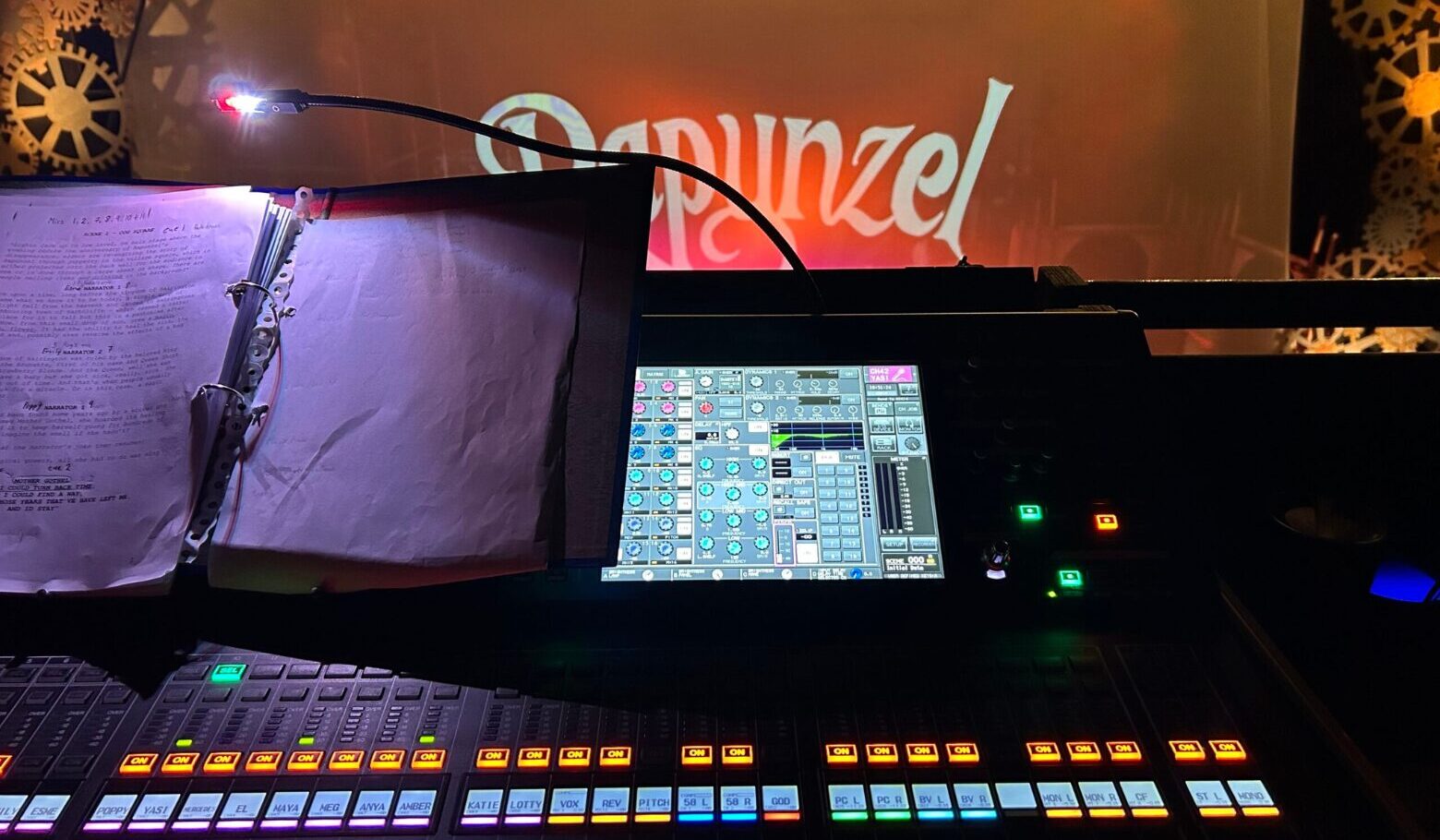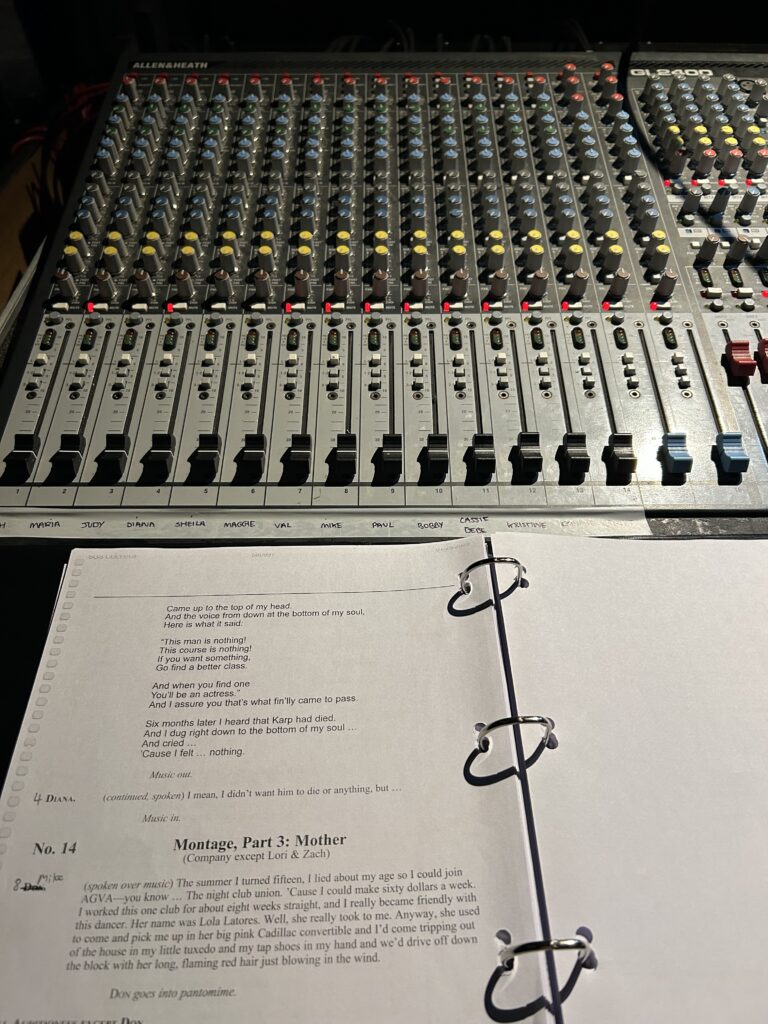Designing and Mixing My First Shows

Since becoming a theatre sound student last September, I’ve had the opportunity to work on two productions in two different spaces. The first was our Christmas pantomime, Rapunzel, and the second was one of the all-time great musicals, A Chorus Line.
First, Rapunzel. I was warned that I’d be thrown in the deep end on this one, and that was certainly true. It was one of the biggest shows of the year, running for two weeks in our 250-seat theatre. We had two shows a day for most of that time: schools performances in the morning and general public in the evening. As sound designer my work started in October, attending production meetings with the director, lighting designer and DSM and going to as many rehearsals as possible. In keeping with pantomime tradition, there were a lot of comical and bombastic sound effects required. One of the most fun to create was a bubbling, hissing cauldron in the witch’s lair. It involved blowing bubbles through a straw in a bowl of water, capturing the sound made by water coming into contact with a stovetop, mixing the two together and adding a lot of reverb! I was quite proud of how it turned out.
I’ll be honest: tech week was incredibly stressful, unlike anything I’ve ever experienced. I had to program a lot of pretty complex sequences in QLab which, considering I’d never done it before, was definitely one of my proudest achievements. There were various technical challenges to overcome and a few tensions along the way, which is to be expected during any tech run. I think it’s fair to say every department struggled with the first dress rehearsal. However, everything suddenly seemed to click into place afterwards and by the time we opened, everyone had found their flow.
As well as designing, I was also required to mix the show: something I know would not have been the case in a professional environment, but in this case we didn’t have the luxury of a larger sound department. My desk was a Yamaha QL5 and we had a cast of 19 actors and six dancers, with 14 radio mics at our disposal (swaps and breakages were involved). The moment of terror described by many theatre sound engineers just prior to their first ever show is now 100% relatable to me! Dress had gone well, soundcheck had gone well, but part of me was still thinking, “Is it too late to run away?” That nervous energy remained before each subsequent show, but I soon found I was able to channel it into pure focus as soon as the curtain went up. And when we got to bows, applause and cheers, that feeling of exhilaration would hit and I’d think: That’s why I wanted to do this!

The feedback I got from my tutors, the director, cast and my fellow crew, as well as the response from audiences, gave me confidence and assured me that all of the hard moments had been worth it. I certainly understand now why people say pantomime is one of the toughest things you can work on, but when it goes well, it’s so rewarding.
After Christmas it was straight into rehearsals for A Chorus Line. This show took place in our smaller studio theatre and was more straightforward in that there were no sound effects required, just tracks (and in this case QLab was operated by our DSM). I used an Allen & Heath analogue desk this time, so it was really good to get experience of a different setup. We had a cast of 15 and needed 14 radio mics and one handheld for the director character. Inevitably there were some breakages, which made mic swaps a bit of a challenge as the majority of the characters were on stage most of the time, with no interval. It was a bit easier later on in the show, as we had solos from Diana, Cassie and Paul which provided more opportunity for swaps.
My biggest takeaways from these two experiences have been:
- No matter how stressful all the preparation might be, there is no better feeling than when a show comes together and knowing that you were part of making it happen
- Paperwork, paperwork, paperwork! It may not be one of the most interesting parts of the job, but it’s so important to get it right so that the sound, and the show, runs as smoothly as possible. And when you need your Sound No.2 to take over mixing duties, they have to be able to understand your notes and everything you’ve written in your script.
- For reasons I’ll elaborate on in my next post, there were times when I doubted that I could really do this. But on Rapunzel, I proved to myself that I could, and I was able to take that confidence and experience onto A Chorus Line. In turn, I’ll take that plus more onto the next show I do.
Article by: Sarah Stacey
Back to Home
Editor's Note: At StageLync, an international platform for the performing arts, we celebrate the diversity of our writers' backgrounds. We recognize and support their choice to use either American or British English in their articles, respecting their individual preferences and origins. This policy allows us to embrace a wide range of linguistic expressions, enriching our content and reflecting the global nature of our community.
🎧 Join us on the StageLync Podcast for inspiring stories from the world of performing arts! Tune in to hear from the creative minds who bring magic to life, both onstage and behind the scenes. 🎙️ 👉 Listen now!
